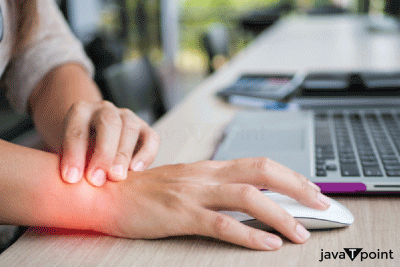Repetitive Motion DisordersA category of musculoskeletal conditions known as repetitive motion disorders (RMDs) are brought on by repetitive motions during routine work or daily activities. The disorders are brought on by excessive repetitions of an activity or action, unusual or awkward movements including twisting the arm or wrist, overexertion, bad posture, or muscle weariness. Some examples of repetitive motion disorders are- 
RMDs can affect the neck, back, hips, knees, feet, legs, and ankles, however they normally only impact the hands, wrists, elbows, and shoulders. The following signs and symptoms set the illnesses apart:
Some people may have no apparent signs of injury, yet they may have difficulty performing relatively simple tasks. RMDs can result in tissue compression or temporary or permanent damage to the body's soft tissues, including muscles, tendons, ligaments, and nerves. RMDs commonly affect those who work on an assembly line, at a bar, packing meat, stitching, playing an instrument or on a computer. The disorders may affect people who engage in activities like tennis, gardening, and carpentry. The motions that cause symptoms must be reduced or stopped as part of the treatment.
Applying ice to the injured area will help to reduce pain and swelling, as will using painkillers, cortisone, and anti-inflammatory drugs. Splints may be helpful to reduce muscular and nerve pressure. Aches and pains in the muscles and joints can be reduced with physical therapy. In rare cases, surgery may be necessary to relieve symptoms and prevent long-term damage. Some firms have created ergonomic programmes to assist employees in adjusting their work pace and arranging office equipment to minimise issues. Most people with RMDs heal completely and can avoid re-injury by modifying how they do repeated motions, how frequently they perform them, and how long they rest between movements. RMDs can result in irreparable harm and loss of function in the affected area if they are not treated. RMDs can induce symptoms due to muscle exhaustion, local inflammation and edoema, or nerve tissue compression. RMD examples include:
It should be noted, however, that all of the disorders listed above may have other origins and arise in the absence of repetitive activity. Who Is Subject to RMDs?A RMD can be obtained by anyone who engages in repetitive activities. Certain occupations and activities, for example, include:
What are the Signs of RMDs?The following symptoms could be brought on by one or more of these illnesses:
Injuries induced by repetitive activities usually develop gradually over time. Initially, the symptoms may be moderate and intermittent. However, if the symptoms are not treated, they can become excruciatingly painful and even incapacitating. RMD TreatmentThe first step in treating RMD is to decrease or eliminate the movements that are generating the symptoms.Other treatments may include:
Prevention RMDs can be avoided.Use the following helpful hints to lower your chance of a repetitive motion injury:
Maintain Your HealthAvoiding RMDs is important if a person is working in a job or often participate in hobbies that need repetitive motions. Rest, regular exercise, and appropriate technique are all essential for avoiding injury. Consult the doctor if the person are suffering any of the symptoms.
Next TopicPolymyositis
|
 For Videos Join Our Youtube Channel: Join Now
For Videos Join Our Youtube Channel: Join Now
Feedback
- Send your Feedback to [email protected]
Help Others, Please Share









